| Location: | Baltimore, Maryland |
| Venue: | Baltimore Convention Center |
| Date: | August 19th - 21st, 2005 |
| Attendance: | 22,000 |
| Photos: | 902 |
Otakon 2005 was held August 19th – 21st, 2005, in Baltimore, Maryland. Having reached the capacity of the convention center, registrations for normal attendees were limited to 22,000. More than 19,000 pre-registrations and about 3,000 at door registrations filled up Otakon by early Friday morning. Ten local hotels filled their convention blocks, with numerous attendees staying in non-convention block rooms.
Location
Since 1999, Otakon has been held in the Baltimore Convention
Center, located in downtown Baltimore, Maryland, right on the Inner Harbor
tourist district. For the largest anime- and manga-themed convention on the
east cost, Baltimore is well situated between New York City and Washington, DC, pulling from the major metropolitan areas between, and still being within
reasonable traveling distance for fans from most east cost states and reaching
a ways into the Midwest, as well. The multitude of hotels, retail outlets,
tourist attractions, and (perhaps most important to convention attendees)
restaurants within easy walking distance make Baltimore one of the best
locations for Otakon.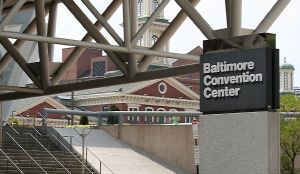
Baltimore does have its share of problems, though. In late summer, the temperatures are high and the weather is usually muggy or rainy. It makes the walk of several blocks between convention center and hotel feel much longer and much less pleasant. Both automotive and pedestrian traffic is very heavy in the Inner Harbor, meaning waits and lines about anywhere one goes. While the Inner Harbor area itself is generally safe, late at night and outside the tourist areas Baltimore's criminal elements are quite visible and at best a big nuisance. Perhaps this is why the BCC closes over night, to force people back to their hotels at a semi-reasonable hour and to avoid dangerous confrontations.
This is really a symptom of the main Otakon problem, in my opinion. Even with the Sheraton and Hyatt directly adjacent to and connect with the Convention Center, there is no feel of a central convention space. The Charles Street lobby, with beautiful fountains and plenty of open space, is the most central, but lacks any particular functionality of its own. During the busy day, of course, it's good to have things spread out enough to keep any one location from becoming over trafficked and jammed. Convention attendees are often quite nocturnal, though, so during the later hours, a place to gather and socialize would be nice. Much of the fun of conventions comes from the more spontaneous and happenstance events. In the past, the larger skywalk area became the late night story spot for those attendees still out and about after closing.
A controversial plan to build a (publicly funded) Hilton directly adjacent to the convention center would solve this problem. It is designed as a hotel headquarters for the convention center. Facing stiff competition from DC and Philadelphia, the BCC is losing revenue as conventions move elsewhere. While such an addition (probably just south of the west wing holding the 400 level Ballroom and across the street from Camden Yards) may or may not help bolster business for the convention center, it would we beneficial should Otakon continue to be held in Baltimore in 2008, when it is scheduled to open. The extra convention space would allow Otakon to expand both programming and attendance, and provide a location for events which can't be held in the convention center.
In any case, finding a convention center capable of holding an event as big as Otakon requires quite a bit of planning ahead of time. Most likely, the venue has already been set for the next two or three years. The good news is, with Otakon bringing $22,000,000 (yes, twenty-two million dollars) to her host city each year, any location will be offering all they can to make it a pleasurable experience for all involved. In other words, wherever Otakon goes in the near future, it should be a good choice.
Attendees
When anime conventions first started out, it was overwhelmingly populated by college-age men. As shoujo popularity increased and anime outside the stereotype started getting released, the demographic started involving younger persons and became balanced in the genders. With anime readily available on television – and the fans from “back in the day” now starting to have their own kids – there's a very broad range of attendees, from young to old. Otakon is getting pretty much the same slice of the population one finds at other conventions; mostly older teens and those in their twenties, but a noticeable amount of persons outside this core range.
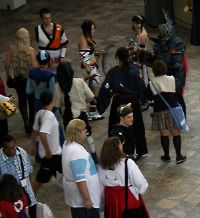 With its sheer size, Otakon gets a very broad range of
attendees, but this year, the attendance cap somewhat galvanized the members.
Those who were the most interested in going, probably those who are more
ingrained in the hobby, were the ones who preregistered early and made it in.
The more casual person who plans for the convention only a week or so ahead of
time was probably turned away due to capacity having already been reached.
Even those who did manage to get an at-the-door badge had to line up early, a
sign of their commitment to the hobby. So, this year, it really was a
convention of more fanatical people than in the past, and compared to other
conventions.
With its sheer size, Otakon gets a very broad range of
attendees, but this year, the attendance cap somewhat galvanized the members.
Those who were the most interested in going, probably those who are more
ingrained in the hobby, were the ones who preregistered early and made it in.
The more casual person who plans for the convention only a week or so ahead of
time was probably turned away due to capacity having already been reached.
Even those who did manage to get an at-the-door badge had to line up early, a
sign of their commitment to the hobby. So, this year, it really was a
convention of more fanatical people than in the past, and compared to other
conventions.
Though “geek” has become “chic” in the last few years, the anime and manga fandom is still (authentically) geeky, and still home to more timid dispositions and an overtly obvious penchant towards particular genres, shows, characters, or styles. With a slightly more fanatical segment, the population at Otakon could go from devout hobbyist to social networker and back in the blink of an eye. The same person who in the dealer's room was explaining the intricate web of relationships in a manga would be partying hard at the rave later in the night.
Even as anime and manga become very mainstream, there's still a definite element of dedication and immersion inside the hobby. The cultural and artistic conventions used in the art need some learning to appreciate, there is some definite commitment to finding and watching episodes or reading volumes as they come out, and there is absolutely still some sort of sense of community in the fandom. The hobby still isn't something for everyone, and even if now every lay person probably has some idea of what anime is, it's still something of a “secret handshake” between those who consider themselves fans.
Dealer's Room
In a smart move, the industry section of the Dealer's Room was placed at the entrance, impressing everybody walking in with the bright displays, screens with video and music, and announcers promoting their goods. Past that section, the traditional tables-and-booths started, with over 250 tables packed full of merchandise. As in the past, the huge 100 level halls were packed, but with aisles wide enough to prevent too much crowding or traffic congestion.
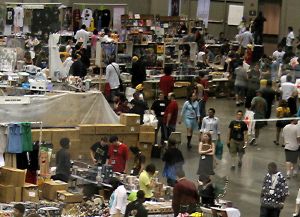 Even though I didn't have much time to look around, I probably would have looked around more if there had been more interesting stuff to see. While a few places had sword recreations and the newest and latest from Japan, many booths seemed to offer the same products one sees elsewhere. With so many of these same merchants offering the same products online, the novelty of the Dealer's Room has slightly declined. Nevertheless, most anybody could find something they were looking for. The variety was large, and prices seemed generally reasonable. Even if there were no “big-hot-and-new”
showstoppers, many places sold out of popular items by Friday afternoon.
Even though I didn't have much time to look around, I probably would have looked around more if there had been more interesting stuff to see. While a few places had sword recreations and the newest and latest from Japan, many booths seemed to offer the same products one sees elsewhere. With so many of these same merchants offering the same products online, the novelty of the Dealer's Room has slightly declined. Nevertheless, most anybody could find something they were looking for. The variety was large, and prices seemed generally reasonable. Even if there were no “big-hot-and-new”
showstoppers, many places sold out of popular items by Friday afternoon.
With such trends, many dealers are probably viewing Otakon as an opportunity for wholesale as much as a retail outlet to customers. Even with online stores, the brick and mortar buildings are usually not in any real competition with each other, and merchants can find products to place in their retail outlets available at wholesale from others at Otakon. Perhaps it's even a good way to discuss buying trends and find market connections.
The attendance cap seemed to hurt dealers, though. Since no single day registrations were available, attendees who come to the convention to stop by and see what's going on were turned away. These are often those who come for a day just to shop, or who are relatively unfamiliar with the hobby and are apt to buy unique items they come across in the Dealer's Hall. With a larger segment of attendees focused on other things, Friday turned out to be the bigger selling day, which is normally Saturday (when single-day attendees would have come). Overall, though, probably a good profit for all the merchants in attendance.
Cosplay
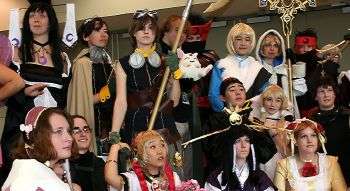 With a convention as big as Otakon, there are all kinds ofdifferent costumes. They range from the simple to the complex, the good to the bad, the uncommon to the everyday. My overall impression is actually quite good. Perhaps I'm jaded, perhaps I was just so busy taking photos of the good costumes I missed others, but I got the definite impression that there were fewer poorly done costumes than average. Granted, there seemed to be a few lesser good costumes as well, but overall the ratio seemed to be slanted towards quality work. Even if there were fewer costumes overall, there were still more than anybody could shake a stick at!
With a convention as big as Otakon, there are all kinds ofdifferent costumes. They range from the simple to the complex, the good to the bad, the uncommon to the everyday. My overall impression is actually quite good. Perhaps I'm jaded, perhaps I was just so busy taking photos of the good costumes I missed others, but I got the definite impression that there were fewer poorly done costumes than average. Granted, there seemed to be a few lesser good costumes as well, but overall the ratio seemed to be slanted towards quality work. Even if there were fewer costumes overall, there were still more than anybody could shake a stick at!
While I can appreciate an elaborate, complex, reality-defying costume, one nice thing about cosplay at Otakon is that with so many cosplayers, there are some very original ideas which may not be quite as elaborate or complicated as other costumes that stand out, but are still very creative and in that sense more interesting. With cosplay apparently becoming more competitive and drama-ridden, it's nice to see a lot of people are still doing it just for the fun of it. Maybe it's better than I remember it, because not once did I ever get a snooty attitude about a costume or having a picture taken. (Of course, I always ask nicely, but that hasn't always helped before.)
Masquerade
Once again, I had the pleasure of participating in judging for both the hall cosplay competition on Saturday and skit judging during the masquerade. I was quite pleased with the costumes I saw for hall judging. As mentioned above, I got the impression that most entrants were doing it just for fun, competing as much for the opportunity to show off their costume as much as to win an award. Occasionally, though, I did wonder about some of the entrants; a few costumes were obviously completely store bought and unoriginal. Maybe they were just really desperate to show off their costume. For each questionable entrant, though, there were several impressive costumes; and for the most part, those entrants were quite friendly and easy to talk to.
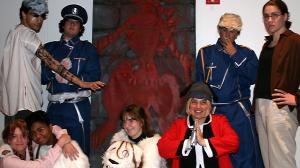 As for the actual masquerade, that was even better. With a
front row seat, I could actually hear some of the dialogue and music that the
microphones didn't pick up. I got a good view of the action and the entrants,
so I could fully appreciate almost every skit. A word to participants, though:
I may have been able to hear and see what was going on, but good stage presence
is what it takes to let the whole audience of three-thousand enjoy your work.
Luckily, most entrants did this pretty well, from what I could tell of the
audience. The audience, unfortunately, has the attention span of a kitten on
caffeine, so any skit that doesn't keep bringing in new material will bore them
quickly. Again, luckily most skits did this right, making the whole affair go
by rather quickly and enjoyably. There were a few skits that were at a league
of their own at the bottom of the ranking, but pretty much every other skit
made up for the poorer ones, and the whole affair was enjoyable and
entertaining.
As for the actual masquerade, that was even better. With a
front row seat, I could actually hear some of the dialogue and music that the
microphones didn't pick up. I got a good view of the action and the entrants,
so I could fully appreciate almost every skit. A word to participants, though:
I may have been able to hear and see what was going on, but good stage presence
is what it takes to let the whole audience of three-thousand enjoy your work.
Luckily, most entrants did this pretty well, from what I could tell of the
audience. The audience, unfortunately, has the attention span of a kitten on
caffeine, so any skit that doesn't keep bringing in new material will bore them
quickly. Again, luckily most skits did this right, making the whole affair go
by rather quickly and enjoyably. There were a few skits that were at a league
of their own at the bottom of the ranking, but pretty much every other skit
made up for the poorer ones, and the whole affair was enjoyable and
entertaining.
Much of the improvement to the masquerade competition can be credited to the masquerade director. A database system recorded the judges' scores quickly and had predefined queries to determine the proper awards. After the winners were known, it was soon just a matter of announcing them. Unfortunately, we judges were somewhat cut out of the loop at this point, having fulfilled our purpose. I was ushered on stage for a hall cosplay award, but without knowing how to present it. I managed out a “Congratulations!” and a handshake; I hope the entrant got some sort of prize once she got off stage. The winners would probably appreciate a chance to have just one more moment on stage, but by rushing things, it did wrap up the event pretty quickly. Many cosplayers were probably in their costumes since the early afternoon, and had been sitting around for three or four hours already, and probably just as interested in getting out of costume and relaxing by that point. Ultimately, it's hard to keep it short and give everybody the time they need, so I'll just say I think the balance was fairly good.
Photos / Press
Sharing my convention pictures and thoughts on the internet has given me an opportunity to join the Otakon Press Corps, I'm proud to say. The joining requirements were much stricter than in previous years, requiring members to prove a certain amount of exposure and professionalism in their work. Of course it's easy to say for somebody who made the cut, but it was a good move on Otakon's part. For starters, it gives those in the press corps a certain amount of legitimacy; guests, cosplayers, and anybody else interviewed or photographed know they are dealing with somebody who is probably worth their time to interact with. It probably also cuts down on a few embarrassments as members of the press corps (presumably) are better at interacting with others, especially guests. In the past, I've been embarrassed for both guests and the person asking their translator a question, instead of the guest themselves. (This is a big no-no, and I would think it's pretty self obvious, though we were once again reminded this year.) Finally, Press Corps members have a record on file with the press department which keeps track of their contributions and actions, so that poor behavior will have repercussions. All in all, it's good to see Otakon take their image and event very seriously.
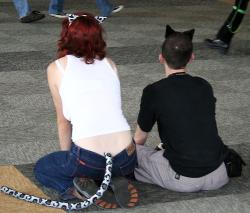 As for photography, I recently upgraded from a Kodak
EasyShare 4330 to a Canon Digital Rebel XT. While the EasyShare provided me
with quality pictures, I was pushing it to its limits. I had to work around
the limitations of the camera for shots with difficult lighting or perspective,
and started to get annoyed with the purple fringing, noise, and limited control
over the camera. The kit lens has exceeded my expectations, and the camera
modes made it easy enough to take quite a few pictures I'm happy with despite
having no prior experience with SLR cameras. I do wonder a bit if having a
more impressive-looking camera makes cosplayers (subconsciously) more willing
to pose and take the time for multiple shots.
As for photography, I recently upgraded from a Kodak
EasyShare 4330 to a Canon Digital Rebel XT. While the EasyShare provided me
with quality pictures, I was pushing it to its limits. I had to work around
the limitations of the camera for shots with difficult lighting or perspective,
and started to get annoyed with the purple fringing, noise, and limited control
over the camera. The kit lens has exceeded my expectations, and the camera
modes made it easy enough to take quite a few pictures I'm happy with despite
having no prior experience with SLR cameras. I do wonder a bit if having a
more impressive-looking camera makes cosplayers (subconsciously) more willing
to pose and take the time for multiple shots.
The fountains by the Charles Street lobby are a nice location to shoot, but the 300 level terrace was a charm. The flora provided a colorful setting against the stark grey buildings in the background. Higher up off the ground, there were usually no cars and few people in the background to distract from the subject of the photo. Though the rain on Friday made things muggy, the overcast clouds made for good exposures. In general, the light in the convention center is pretty good, though the hallways below the café and behind the registration area are usually too dark. The hallways are also usually spacious enough to pull a subject over to the side where the background is better and nobody has to block a pathway.
With about nine hundred pictures, about eight-hundred fifty were usable, which is a numerical improvement over the six hundred or so I can usually take. I'll post some of my favorites over at Cosplay.com if you'd like to leave a comment, but my main galleries will be here on my website. I'm working with post-processing to improve the image quality, but if anybody has any tips or recommendations, I'd be happy to hear them.
Puffy AmiYumi
The panel was listed as the Sony (Music) panel, but announcements all over the place meant everybody knew it would be the Puffy AmiYumi panel. They were late due to construction and traffic along (presumably) Route 295, which is the most direct route from BWI airport to downtown. Their manager, Kaz, took a few questions, and their promotion agent showed a few music videos and an upcoming episode of Hi Hi Puffy AmiYumi from Cartoon Network. While the show airs in the US, Canada, parts of Europe and Asia, it doesn't air in Japan, so their manager was probably a bit surprised with what he saw.
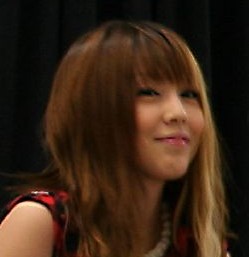 Anybody at the panel probably remembers the guy in the
fourth or so row complaining about pictures. In case you weren't there, both
the Press Department head and the promotion manager spelled out the rules. No
videotaping or audio (for obvious reasons) and photography only by press
members for the first three minutes, and no flash. Well, he felt left out, I
guess, and made a fuss about it. Why no photography from anybody else? As
mentioned, those are the rules, period. That's all anybody really needs to
know. For those that are interested, though, here's a good guess on my part.
Anybody at the panel probably remembers the guy in the
fourth or so row complaining about pictures. In case you weren't there, both
the Press Department head and the promotion manager spelled out the rules. No
videotaping or audio (for obvious reasons) and photography only by press
members for the first three minutes, and no flash. Well, he felt left out, I
guess, and made a fuss about it. Why no photography from anybody else? As
mentioned, those are the rules, period. That's all anybody really needs to
know. For those that are interested, though, here's a good guess on my part.
Flashes are distracting. With maybe sixty press members, the flashes would be tolerable; 400 flashes can be pretty disorienting, as many cosplayers can attest to. Of course, the press people will know how to turn their flashes off and abide by the rules, which others may not. Just as far as flashes go, there's already a good reason. And, press people will (presumably) also know how to get a good shot from a difficult angle with bad lighting. Most people, trying to take a flash picture from the middle of the room with a bunch of other people around them trying to do the same thing probably won't net any useable pictures, anyways. And as far as numbers go, it's one thing to have a few press people kneeling in front of the panel table for a few minutes, and something much different to have 400 people crowding the aisles to get a snapshot. At that point, it's not just a comfort issue for the guests, but a safety issue for everybody in the room. Finally, the press and public relations people work for the attendees to allow as much as possible; it was a bit rude to first “kill the messenger,” and then argue with the people in charge.
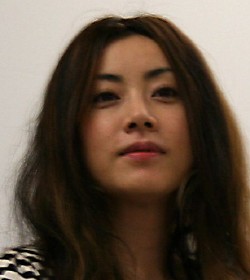 Before too long, though, the girls came in with much
applause from the audience. They had an engagement in Philadelphia the next
evening, so they needed to keep a schedule as tight as possible, even if that
meant cutting the panel short. (They did stay past the scheduled time, just
not as long as a full hour.) A promo quiz came first, with some very easy and
very difficult questions to win a pair of drum sticks, a bag, and some other
assorted goodies. The final item was a pair of tickets to the concert at the
9:30 Club in DC on Monday. Instead of a quiz, they gave them away to the
person with a birthday (and an ID to prove it) that Friday. After the quiz,
they answered a few questions from the audience. They were pretty friendly and
jovial about it all, despite some of the questions being somewhat silly or leading
to uninformative answers. I would have liked to hear some more relevant
questions, such as about upcoming tours or the newly released album. Then
again, I kept my hand down so a fan could ask a question to their musical heroes
instead.
Before too long, though, the girls came in with much
applause from the audience. They had an engagement in Philadelphia the next
evening, so they needed to keep a schedule as tight as possible, even if that
meant cutting the panel short. (They did stay past the scheduled time, just
not as long as a full hour.) A promo quiz came first, with some very easy and
very difficult questions to win a pair of drum sticks, a bag, and some other
assorted goodies. The final item was a pair of tickets to the concert at the
9:30 Club in DC on Monday. Instead of a quiz, they gave them away to the
person with a birthday (and an ID to prove it) that Friday. After the quiz,
they answered a few questions from the audience. They were pretty friendly and
jovial about it all, despite some of the questions being somewhat silly or leading
to uninformative answers. I would have liked to hear some more relevant
questions, such as about upcoming tours or the newly released album. Then
again, I kept my hand down so a fan could ask a question to their musical heroes
instead.
Even the question and answer session was short, and the girls had to leave again. As a thanks to the audience, though, the promo manager handed out note holders (page sized clear plastic sheets for holding individual papers) with Ami and Yumi photographed on one side and in cartoon form on the other. A nice souvenir from a panel that ran too short, and a good way to let the guests out of the room before the deluge of fans.
The concert on Monday was fantastic. (This was not part of Otakon! It was a separate event held in Washington, DC, on Monday after the convention.) It started promptly at eight. I'm not (yet) a big fan of theirs, so I didn't know most of the songs, but as the Washington Post described the duo, even if you don't understand the lyrics, the spunky pop-music energy of their songs comes through in abundance anyways. The 9:30 club is a fairly small, standing-room-only venue in downtown DC. Despite the small size, they do manage to get some fairly big acts. It's a full fledged club, with a stage, bar, dance floor, and mesmerizing lighting. A U-shaped balcony allows viewing the stage from above, though from my position in the back I could still see very well. (Granted, this is thanks to standing 6' 4”, well above most people in front of me.)
The crowd was interesting. Mostly the same type you'd expect to see at Otakon, but a surprising number of youngsters (say, 6-10 years old), as well as some Japanese folk who may have felt oddly out of place at a Japanese concert filled with mostly non-Asians. Convention dances are usually the closest one gets to seeing such a thing, but it was oddly nice to see the same kind of crowd in a real club setting, the kind of setting usually populated by the hardcore dance party types. One and all seemed to be into the show, though, having a good time.
Some of the interesting things were when they announced they'd sing the opening song for the current Pokemon movie in Japan. They were met with much less enthusiasm than they probably expected. I'm guessing most people in the audience didn't know Puffy AmiYumi performed the song in the first place; this was no cover. Only few couldn't get pulled in when one of them said in broken, accented English, “Do you know Pokemon?” And then followed it up with a semi-dejected look and “pi-ka-chu?” Like it or hate it, the crowed became much more enthusiastic and wanted to hear the song.
A funny mishap happened when they introduced their band. Their keyboardist had a bright yellow tee-shirt on, reading, in big red lowercase letters, “poop.” They were reading their English off of cue cards, and accidentally introduced him as “poop,” probably reading the shirt instead of their cards. With an embarrassed laugh and a loud, “no no no!” they properly introduced him. I couldn't make out the gentleman's name over the lingering laughter, though.
At the end, I got another surprise and a small shock. They exited the stage with their band, and people started to leave. (Big mistake.) I kept clapping and clapping until somebody stopped me after about five minutes. Maybe they don't do encores in Japan? Well, almost as soon as I stopped clapping, they came back out on stage for an encore, to much cheering and clapping. Now, it would still have been nice for them to cover a popular anime theme song, but a bit too cliché for me; I'd much rather they do a song they're interested in. Well, apparently they're fans of Green Day, and performed Basket Case. It was absolutely fantastic.
Puffy AmiYumi may come off as a pop-star cutsy act with some talent behind them, but after hearing the live concert, I'm convinced they have all the talent they need. Their performance was very energizing and exciting, the music quite enjoyable with a fair mix of both singing and instruments. Anybody who has found they enjoy any of their work should consider picking up an album and giving it a try.
Conclusions
Otakon is the big anime convention on the east coast. While still run by volunteers and having her share of issues, it has grown to the size it has by being well run and having a wide scope of interests to appeal to many different parts of fandom. The location serves it well, and the nationwide fan base ought to sustain any growth Otakon may undergo. Despite rumors to the contrary, placing Otakon in the Philadelphia Convention Center next year, Otakon will be returning to Baltimore at least for 2006, over the weekend of August 4th – 6th.
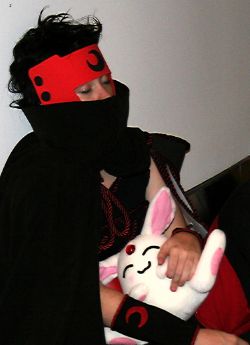 Even though Otakon has been experiencing exponential growth, holding another event with an attendance cap does not have to be a bad thing. Many long running cons have had the same (and often much smaller) attendance cap for years. Keeping things at the current size for a while could allow the staff to focus on improvement instead of working out new issues. Twenty-two thousand attendees insure plenty of exposure for any company hoping to promote its products and plenty of dynamic to keep attendees fresh and happy.
Even though Otakon has been experiencing exponential growth, holding another event with an attendance cap does not have to be a bad thing. Many long running cons have had the same (and often much smaller) attendance cap for years. Keeping things at the current size for a while could allow the staff to focus on improvement instead of working out new issues. Twenty-two thousand attendees insure plenty of exposure for any company hoping to promote its products and plenty of dynamic to keep attendees fresh and happy.
What does the future hold, though? The DC Convention center is in the same general area, with as much as three times the convention space as the BCC, though there are only two hotels in easy walking distance, and only ten total within a half-mile distance. The Philadelphia Convention Center would move the convention farther north, possibly out of the range of people farther than the metropolitan areas of North Carolina. The Gaylord Hotel and Convention Center, billed as the largest such complex on the east coast, will open in 2008 just south of DC as part of the Woodrow Wilson Bridge development project. Overlooking a scenic stretch of the Potomac River and combined with retail, lodging, and food retail outlets, it might be a perfect place for Otakon to move, if it's not already booked out until 2014.
Also in 2008, Baltimore may open a Convention Center Hilton, as mentioned above. Since I'm partial to Baltimore, and feel there is a definite need for a headquarters location to centralize activities, that would be the best option for Otakon in my opinion. That still leaves the question of where Otakon will be held in 2007, but that's probably already been decided. Convention centers book out such full-use availability well in advance, so it's likely Otakon already has a home for the next several years. But, while bringing in $22 Million to the host city, many venues may try to lure them in.
 Otakon is in a good position. She's sturdy enough to
provide top notch entertainment and industry connections. Attendees, who make
the convention what it is, are generally friendly and helpful and courteous, so
there are only few reasons not to attend Otakon. The size, her best attribute,
is also a big drawback in many ways. There is so much to do, most attendees
will miss out on something they wanted to do. It's very difficult to socialize
with others since you may see them once by chance and then never cross paths
again. Even with plenty of sitting space and couches and restaurants in the area,
the sheer mass of people makes it all feel somewhat impersonal. And, again,
late-night activities are next to impossible, breaking any momentum from one
day into the next.
Otakon is in a good position. She's sturdy enough to
provide top notch entertainment and industry connections. Attendees, who make
the convention what it is, are generally friendly and helpful and courteous, so
there are only few reasons not to attend Otakon. The size, her best attribute,
is also a big drawback in many ways. There is so much to do, most attendees
will miss out on something they wanted to do. It's very difficult to socialize
with others since you may see them once by chance and then never cross paths
again. Even with plenty of sitting space and couches and restaurants in the area,
the sheer mass of people makes it all feel somewhat impersonal. And, again,
late-night activities are next to impossible, breaking any momentum from one
day into the next.
Ultimately, though, no convention can do it all. Smaller cons are great for socializing in a more vacation-like atmosphere. Large cons like Otakon and Anime Expo are all about the hobby. With the Days Inn already sold out within a week after Otakon 2005, it's pretty clear there's plenty attraction to the convention. Otakon is undeniably an event for everybody in the hobby.
Links
- Add a Link! (email form)
Standard Disclaimer
If you wish to link to the website, please link to the main page, http://www.orobouros.net, and please don't link to any images directly from other web sites. You are granted permission to use these images for your own personal use (such as cosplay sites, personal web pages, etc) provided they are not altered in any way except for rotation, cropping, resizing, resolution, and mirroring. Any other altering of these images requires my permission. I reserve the right to revoke use of these images at any time for any reason. This is done for the protection of the subjects of these pictures. If you are the subject of any of these pictures, and wish your likeness to be removed from this web page, please contact me with the file name and the page it appears on. Unless there is considerable doubt that you are not the subject of the picture, your request will be granted in a timely manner.